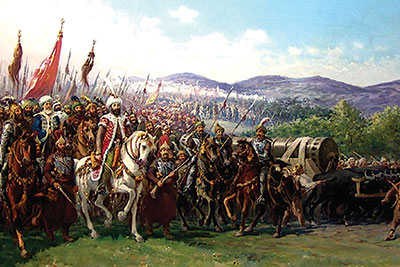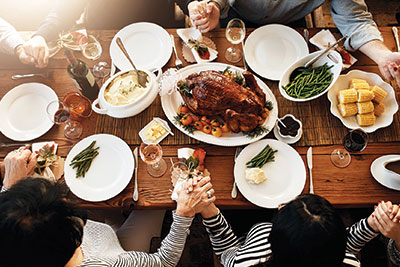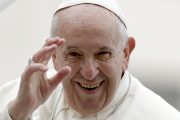
In a time of economic freefall, of rampant lawlessness on our southern border and in our cities, of dangerous new rivals abroad such as Communist China and Islamist Iran, and of a stubborn pandemic that has become a pretext for eradicating individual liberty, it might seem that Americans have little to be thankful for. Those of us whose memory reaches back a few decades find the America of today to be virtually unrecognizable, with a culture seemingly hostile to values and institutions once taken for granted. With a government now unable and unwilling to maintain even a semblance of civic order, public and private debt soaring to incomprehensible heights, and moral and civic virtue all but banished from politics and popular culture, the America that rose to become the greatest nation in history in the 20th century appears poised for collapse in the 21st. Small wonder, then, that in recent years, Thanksgiving has been reduced to a placeholder between two holidays that better epitomize consumption and secular festivity, temporary escapes from a world spinning out of control.
Considering the origins of Thanksgiving, it was once widely taught that the holiday arose as a memorial to the Pilgrims who first settled New England, who, in spite of perilous circumstances in an unforgiving wilderness, managed, with the help of sympathetic Indians, to harvest, hunt, and otherwise acquire enough food to survive their first brutal winter on the American continent. Less remarked, amid the cornucopias, turkeys, and other festive symbols, are the circumstances that drove them to the New World in the first place — and the conditions they left behind in the Old.
Conditions in Europe in the 1620s were nothing short of calamitous. Central Europe was newly embroiled in what would come to be known as the Thirty Years’ War, a desolating conflict between Catholic and Protestant countries that would drag on until 1648, taking an unprecedented toll in life, not only from battlefield dead, but also from widespread starvation and disease occasioned by the bitter, protracted contest.
Meanwhile the Dutch, one of the two main sources of 17th-century immigrants to the American colonies (including a significant number of the Pilgrims and first Puritans), were facing off against the mighty Spanish empire in the Eighty Years’ War, one of history’s longest wars of independence. Begun in 1568 as a revolt by what is now Belgium, Luxembourg, and the Netherlands against Spanish rule, the war coalesced in 1619 with the Thirty Years’ War, and finally ended in 1648 with the general recognition of an independent Dutch Republic.
England, besides being involved in the Thirty Years’ War, was in very bad financial shape owing to the extravagance of James I. This state of affairs would improve after 1625 with the accession of James’ more disciplined son, Charles I — but at a significant cost to English liberty. Charles effectively ended English involvement in the war on the continent and set about paying down the debts of the Crown, but he also disbanded Parliament and ruled England with an iron fist for 11 years, actions that set the stage for a debilitating civil war between monarchists and parliamentarians that broke out in 1642 and lasted for nine years.

On the march: Europe in the early 1600s, when the first English and Dutch settlers were migrating to the New World in search of a better life, was a perilous place. (Photo credit: http://www.insecula.com/us/oeuvre/O0025023.html)
Besides these wars, another terrifying threat menaced the entire Western world in the early 17th century: the threat of Islamic conquest at the hands of the almost-unstoppable Ottoman Turks. The Ottoman Empire’s rise to world superpower with the conquest of Constantinople in 1453 was but the latest in a long string of Turkish victories against the Christian world, stretching all the way back to Manzikert in 1071. Despite several 16th-century Ottoman setbacks at the Siege of Malta in 1565 and the naval Battle of Lepanto in 1571, the Turks set their sights on the conquest of western Europe by land, ultimately leading a massive invasion force into the heart of Hapsburg dominions in 1683 and laying siege to the city of Vienna. It was here, after centuries of warfare stretching back to the Crusades, that the mighty Turkish forces were finally defeated decisively by a coalition of European states in a battle that may have quite literally saved Christendom from destruction. But all of this lay in the future in the 1620s, when the European nations were crippled by internecine war and when eventual conquest by the disciplined armies of the crescent seemed all but inevitable.
And there was another specter looming over Europe, the so-called Black Death, whose first dreadful appearance in western Europe in 1348 led to the deaths of as much as half the entire population of Europe over the next three years. Nor did this pandemic come to a tidy end like the Spanish flu; for more than three centuries, the plague continued to ravage Europe annually, although never on quite the scale as the initial onset. But during the entire period from the mid-14th century until near the end of the 17th century, Europeans lived in constant terror of the awful disease, and for good reason: A plague epidemic was recorded somewhere in Europe in every year from 1400 to 1671, except for 1445.
In Italy, which had been hit the hardest in the original pandemic, the plague returned with a vengeance repeatedly. From 1478 to 1482, for example, the plague ravaged many of Italy’s largest cities, killing several hundred thousand in Venice alone. Another outbreak occurred in 1527 during a conflict between Florence and Rome and, in the case of Florence, wiped out one quarter of the city’s inhabitants.
Nor was northwestern Europe spared. The city of London was ravaged again and again, with the Great London Plague of 1563 killing one quarter of the city’s population. Further outbreaks in 1593, 1603, and 1625, culminating in the Great Plague of London of 1665-1666, killed around 100,000 people, or another quarter of that city’s unfortunate inhabitants. Holland fared little better, with a massive outbreak claiming one-tenth of Amsterdam’s population from 1623-1625, and again 10 years later.
It bears mentioning that the plague was the most dreadful, but hardly the only terrifying disease that ravaged Europe during those challenging times. Smallpox, scarlet fever, cholera, diphtheria, and many other diseases also took a fearsome annual toll.
Thus the world of the Pilgrims, the Puritans, and other 17th-century European immigrants to the New World was a world of continuous warfare — both international and internecine — of unending pandemics, and of political absolutism, where security, health, and individual liberty were elusive phantoms, and where even the hearts of the faithful quailed at the fragility and uncertainty of human life and society. Yet in spite of all of these obstacles — obstacles that had, in large measure, been the rule throughout ages of human history — the peoples of western Europe somehow, falteringly, groped their way into the modern age, discovering along the way the merits of limiting government power, safeguarding individual liberty, and promoting the progress in science and medicine that has so dramatically improved our standard of living over the past several centuries. The Pilgrims of the Mayflower set sail at the very beginning of this great age of human advancement, at a time when such progress was far from self-evident. For all that any of them could have known, their homelands might at any moment be destroyed by civil war, ruptured by political infighting, ravaged by the plague or some other hideous disease, or even overrun and conquered by Ottoman armies.

Time of plenty: Even with the crises and general malaise now afflicting the United States, we still live in an age of unprecedented security and prosperity. Now, more than ever, Thanksgiving is relevant to our condition. (Photo credit: PeopleImages/E+/GettyImagesPlus)
When they arrived in the New World, their old fears were replaced by new ones, equally unimaginable from our comfortable 21st-century perches: capture and enslavement by the Spanish, massacre by the Indians, and, as always, death by cold, starvation, or some dread disease. Indeed, the land on which the Pilgrims settled had been depopulated by an epidemic that had wiped out nearly all of the Patuxet Indians. Arriving at Plymouth in December of 1620, half of the Pilgrims promptly died of cold and starvation during their first winter in the New World.
And so in the spring and summer of 1621, the remaining Pilgrims — diminished refugees from all of the horrors and uncertainties of the Old World — set about, against all odds, to attempt survival in a New World where their faith, at least, could be practiced without fear. With the help of surviving local Indians, they learned how to farm, hunt, and fish in the new terrain, and in the fall of 1621 celebrated their first harvest in the New World, an occasion that guaranteed that some, at least, would live on to build upon the riskiest of foundations and, against all odds, succeed in their quest to build a new type of society. That Thanksgiving feast, which lasted three days, hosted the 53 remaining Pilgrims and 90 Wampanoag Indians. We must suppose that, in addition to giving thanks to Almighty God for their bounteous harvest, they were grateful for merely being alive and free; the material abundance of their descendants was probably not even imagined.
Our age, in contrast to theirs, is a time of plenty, even if somewhat lessened by years of pandemic and financial uncertainty. Some shelves may be empty in America this holiday season but, barring some unforeseen catastrophe, there will still be plenty of food, clothing, and shelter during the coming winter. Inflation will likely wreak havoc on savings and consumer prices — but savings and consumer purchases will continue. The COVID pandemic will likely continue at some level, possibly for years or even generations to come, but is unlikely ever to exact anything like the price imposed by the plague during a pandemic that lasted six human lifetimes. Formidable enemies may continue to threaten and even attack us, but none of them — not even nuclear-armed adversaries — have any realistic chance of conquering the United States. And civil unrest may continue to destabilize, but Western Civilization has seen its like many times before and survived.
None of which is to minimize the many and formidable challenges before us. But if our ancestors could emerge triumphant and grateful in times of enormous, even unexampled adversity, then surely we, this Thanksgiving season, can find it in our hearts to do the same.
Charles Scaliger, a longtime contributor to The New American and former academic at an American university, lives and works in East Asia.
This article was originally published on November 25, 2021.



